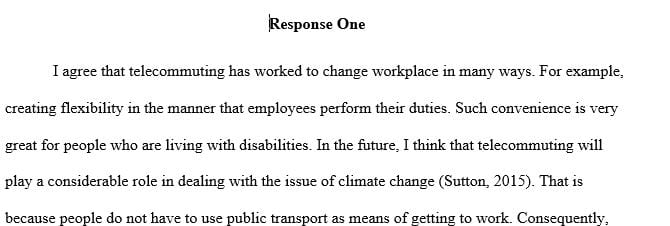Telecommuting is the concept of working from home (WFH) or working remotely
1) Telecommuting is the concept of working from home (WFH) or working remotely. Rather than travelling to the office, the employee connects with the co-workers through telecommunication channels like telephone, email and video meetings. Telecommuting has been in debate over the past few decades. While some companies do promote telecommuting, there are many companies that don’t. This is driven by many factors including the type of job, nature of work, security demands and productivity.
There are many benefits to telecommuting. It provides more space for gaining knowledge and allows employees to accommodate their lifestyles (Pearlson et al., 2020). This is extremely beneficial for those who want to spend more time with their family, or those with disability or illness. In a study conducted by Baruch (2000) on 62 teleworkers form five UK organizations, there was a 76 percent increase in effectivity of the employees after they started working remotely. WFH also provides geographic flexibility, meaning one is free to live wherever he/she wishes (Pearlson et al., 2020). Telecommuting proves to be constructive for the companies as well. It incurs less organizational costs, cuts down on real estate, and aids energy conservation.
With recent advancements in technology, WFH transition can be very smooth. Computers and Internet now have the performance and speed to handle huge workloads. There has been a rise in communication platforms including email, online chat, audio and video conferencing. Also, companies are moving applications and data to cloud platforms like Amazon Web Services (AWS) which facilitate easy access from any grid through secure Virtual Private Networks (VPN). In my company, ever since COVID-19 started, most of the employees are encouraged to WFH. We have been collaborating with each other by using Slack for online chats and Zoom for video conferencing. All our data is in AWS and we connect securely through our VPN to access work data.
However, in few scenarios, WFH is not a possibility. This is mostly tied to manual labor jobs in industries like manufacturing, warehousing, electricity, farming, construction, shipping etc. Employees need to come into the office and handle equipment or tools which cannot be done remotely. Another circumstance which opposes remote job is working in a legal or security compliant role. Due to the confidentiality of the work, WFH is not allowed in these cases. But such kind of jobs are very few compared to the overall job market. In summary, by observing the growth of technology in today’s world, I strongly believe that more companies will adopt telecommuting in the near future. The number of office buildings will reduce and people will commute to work only when it’s absolutely necessary.
2) The growth in telecommuting and mobile will improve a lot in upcoming years, and Investment costs when implementing a program will influence the approaches used in the design and implementation(Vega, 2003, p.143). The availability of well-suited tools for designing, implementing, and testing dramatically impacts system developers (Vega, 2003, p.143). Implementing and implementing the agent-based program should not be a significant overhead. Otherwise, the expense of the solution will increase. Issues of concern are the duration of the technology’s learning process, the time taken to implement software, the quality, the reliability of resources, and supporting content (Vega, 2003, p.143).
According to Vega (2003) studied the highly competitive environment, making the implementation time as short as possible is exceptionally important as the future Internet with its e-commerce will take months or weeks instead of years to implement new services. The project results discussed showed that agent technologies enable cost-effective implementation and easy service customization (Vega, 2003, p.145). Properly chosen interface makes the technology easy to understand and use, significantly reducing the time it takes to introduce.
Besides, the use of an active modeling approach from the service implementers’ point of view can help manage the increasing functional complexity involved in designing and implementing the service (Vega, 2003, p.143). However, agent technology also brings disadvantages. Compared with static implementations, the overhead communication of a mobile agent’s based interface can be significant. The mobile code should be used with consideration to avoid this, e.g., in cases where a dialog between two entities involves extensive data exchange, as is the case in negotiations between two objects (Vega, 2003, p.143).
Answer preview to telecommuting is the concept of working from home (WFH) or working remotely
APA
202 words



